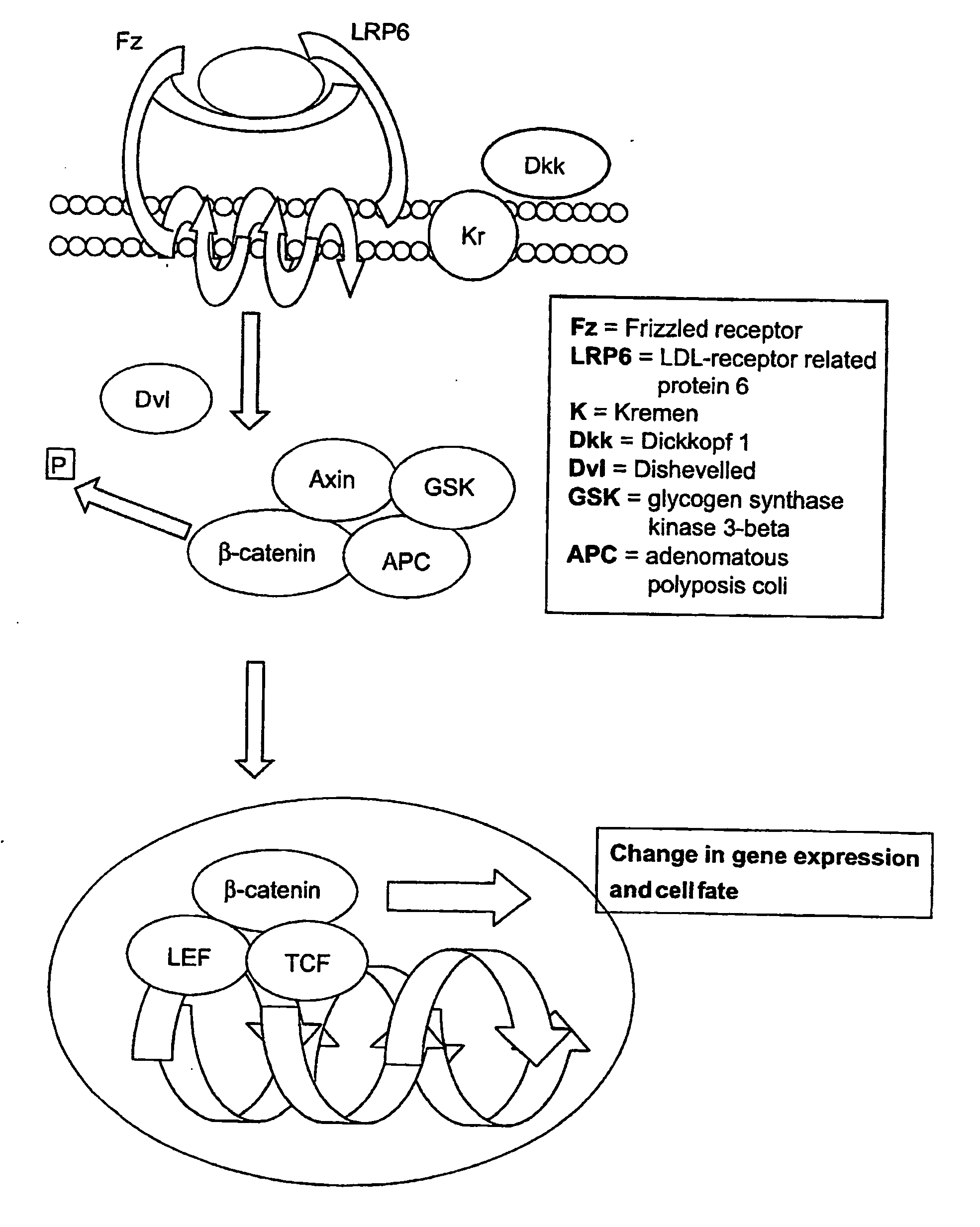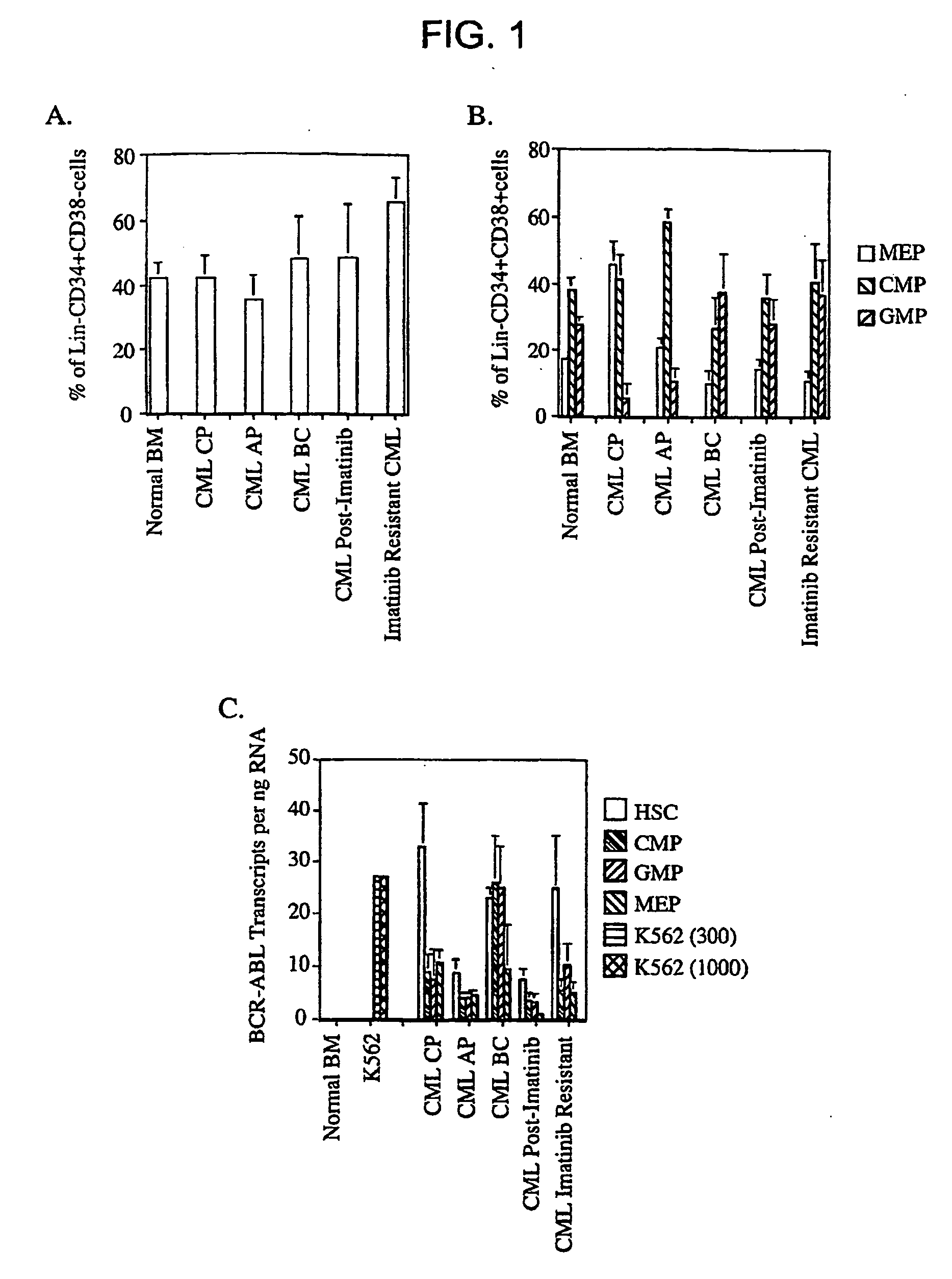Identification, Isolation and Elimination of Cancer Stem Cells
a cancer stem cell and cancer cell technology, applied in the field of identification, isolation and elimination of cancer stem cells, can solve the problem of heterogeneous cd34+ population
- Summary
- Abstract
- Description
- Claims
- Application Information
AI Technical Summary
Benefits of technology
Problems solved by technology
Method used
Image
Examples
example 1
[0123]Fluorescence activated cell sorting (FACS) was used to prospectively isolate highly purified hematopoietic stem cells (HSCs) and myeloid progenitors from chronic phase (CP; n=20), accelerated phase (AP; n=24) and blast crisis (BC; n=12) phase CML bone marrow and peripheral blood samples before, during (CP=22, AP=11, BC=2) and after patients developed resistance to Imatinib (AP=4, BC=1).
Methods
[0124]Bone Marrow and Peripheral Blood Samples. Fresh human bone marrow was obtained with informed consent from healthy volunteers (AllCells, Berkeley, Calif.) as well as from allogeneic bone marrow donors (Department of Bone Marrow Transplantation, Stanford School of Medicine, Stanford, Calif.). Cytokine (G-CSF) mobilized peripheral blood samples were also obtained following apheresis from allogeneic donors. Chronic (CP; n=20), accelerated (AP; n=24) and blast crisis (BC; n=12) phase bone marrow and peripheral blood samples were obtained with informed consent from newly diagnosed patient...
example 2
[0135]Similar experiments were performed with blood samples from CMML patients. The data demonstrate an increase in Flk2 expression by hematopoietic stem cells in a CMML patient.
TABLE 190+90+90−90−FLK2− %FLK2+ %FLK2+ %FLK2− %NBM3923926(N = 4)CMML11124828(N = 4)
[0136]There is an increase of common myeloid progenitors (CMP) in a CMML patient, and as shown in Table 2.
MEPCMPGMPIL-3R++ 45RA+NBM19263117(n = 4)CMML465158(n = 5)
example 3
[0137]The progression of chronic myelogenous leukemia (CML) to blast crisis, which is supported by self-renewing leukemic stem cells. Normal mouse hematopoietic stem cells use the Wnt / β-catenin signaling pathway for self-renewal. We investigated whether leukemic stem cells in CML use the β-catenin pathway for self-renewal.
Methods
[0138]Bone Marrow and Peripheral Blood Samples. Bone marrow (All Cells, Berkeley, Calif.; n=11) or G-CSF mobilized peripheral blood, were obtained from healthy volunteers as previously described, or from patients with CML in chronic phase (n=20), accelerated phase (n=26) or blast crisis (n=13) after obtaining written informed consent and according to Stanford University and UCLA IRB regulations. Cells were obtained from patients before treatment with imatinib, and from patients who had received imatinib for 6 to 15 months (chronic phase; n=22, accelerated phase; n=11, blast crisis; n=2) and imatinib-resistant patients (accelerated phase; n=5, blast crisis; n...
PUM
| Property | Measurement | Unit |
|---|---|---|
| time | aaaaa | aaaaa |
| time | aaaaa | aaaaa |
| time | aaaaa | aaaaa |
Abstract
Description
Claims
Application Information
 Login to View More
Login to View More - R&D
- Intellectual Property
- Life Sciences
- Materials
- Tech Scout
- Unparalleled Data Quality
- Higher Quality Content
- 60% Fewer Hallucinations
Browse by: Latest US Patents, China's latest patents, Technical Efficacy Thesaurus, Application Domain, Technology Topic, Popular Technical Reports.
© 2025 PatSnap. All rights reserved.Legal|Privacy policy|Modern Slavery Act Transparency Statement|Sitemap|About US| Contact US: help@patsnap.com



